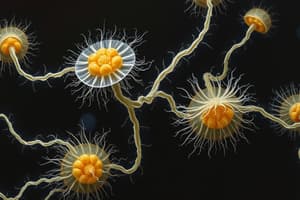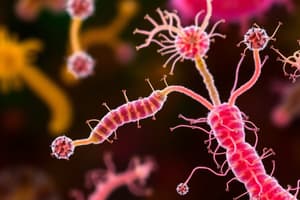Podcast
Questions and Answers
What is the primary structural difference between prokaryotes and eukaryotes?
What is the primary structural difference between prokaryotes and eukaryotes?
- Presence of membrane-bound organelles (correct)
- Absence of circular DNA molecules
- Single, continuous nucleus
- Lack of plasma limiting membrane
Which term describes the circular DNA molecules present in prokaryotes?
Which term describes the circular DNA molecules present in prokaryotes?
- Ribosomes
- Histones
- Plasmids (correct)
- Chromosomes
How do prokaryotic cells differ from eukaryotic cells in terms of cellular organization?
How do prokaryotic cells differ from eukaryotic cells in terms of cellular organization?
- Multiple nuclei
- Membrane-bound organelles
- Presence of nuclei (correct)
- Lack of plasma membrane
Based on molecular evidence, which group, bacteria or archaea, shows more similarities with eukaryotes?
Based on molecular evidence, which group, bacteria or archaea, shows more similarities with eukaryotes?
What genetic relationship has been identified between archaea and eukaryotes?
What genetic relationship has been identified between archaea and eukaryotes?
Which ecological processes are primarily driven by prokaryotes such as bacteria and archaea?
Which ecological processes are primarily driven by prokaryotes such as bacteria and archaea?
What is a key consequence of certain environmental factors favoring either bacterial or archaeal dominance?
What is a key consequence of certain environmental factors favoring either bacterial or archaeal dominance?
In which of the following habitats would one expect to find archaeal dominance over bacterial populations?
In which of the following habitats would one expect to find archaeal dominance over bacterial populations?
Why is understanding bacteria and archaea fundamental to grasping biodiversity in Earth's ecosystems?
Why is understanding bacteria and archaea fundamental to grasping biodiversity in Earth's ecosystems?
How do diverse environmental conditions contribute to the distinct lineages of bacteria and archaea?
How do diverse environmental conditions contribute to the distinct lineages of bacteria and archaea?
Flashcards are hidden until you start studying
Study Notes
Exploring Life's Diversity in Campbell Biology Chapter 27: Prokaryotic Organisms
Prokaryotic organisms serve as foundational knowledge when delving into biology's remarkable complexity. In this chapter of Campbell Biology, we encounter two main groups — bacteria and archaea, collectively known as prokaryotes. Understanding these simple yet vital members of life will enrich our appreciation for the intricate web of biological interactions across earthly ecosystems.
Definition and Characteristics of Prokaryotes
Prokaryotes differ from their eukaryotic counterparts due to several structural differences, primarily concerning cellular organization. Unlike cells with membrane-bound organelles like plants and animals, prokaryotes have simpler structures without nuclei nor membrane-enclosed compartments. Instead, they possess circular DNA molecules located within the cytoplasm, which is encased by a single, continuous plasma membrane called the plasma limiting membrane.
Distinction between Bacteria and Archaea
The distinction between bacteria and archaea has been debated since their initial discovery; however, current molecular evidence reveals significant differences at both genetic and physiological levels. For instance, while bacteria share more similarities with eukaryotes, archaea appear closer relatives based upon shared genes related to transcriptional regulation, protein synthesis, and translation. This leads us to believe that their common ancestor diverged around three billion years ago, creating distinct lineages unique to each group.
Both types of prokaryotes inhabit diverse environments, driving essential ecological processes such as nitrogen cycling and energy conservation through photosynthesis. However, certain environmental factors favor either bacterial or archaeal dominance, leading to different distributions and adaptations within their respective domains. Some examples of habitats where one type predominates over another include marine sediments, hot springs, hydrothermal vents, acidic environments, and alkaline lakes.
In summary, understanding prokaryotes—particularly bacteria and archaea—is fundamental to grasping biodiversity and bioactivity present throughout Earth's ecosystems. Such insights enable researchers to comprehend complex natural phenomena, design novel technologies, and formulate effective strategies against infectious diseases, among other applications.
Studying That Suits You
Use AI to generate personalized quizzes and flashcards to suit your learning preferences.





